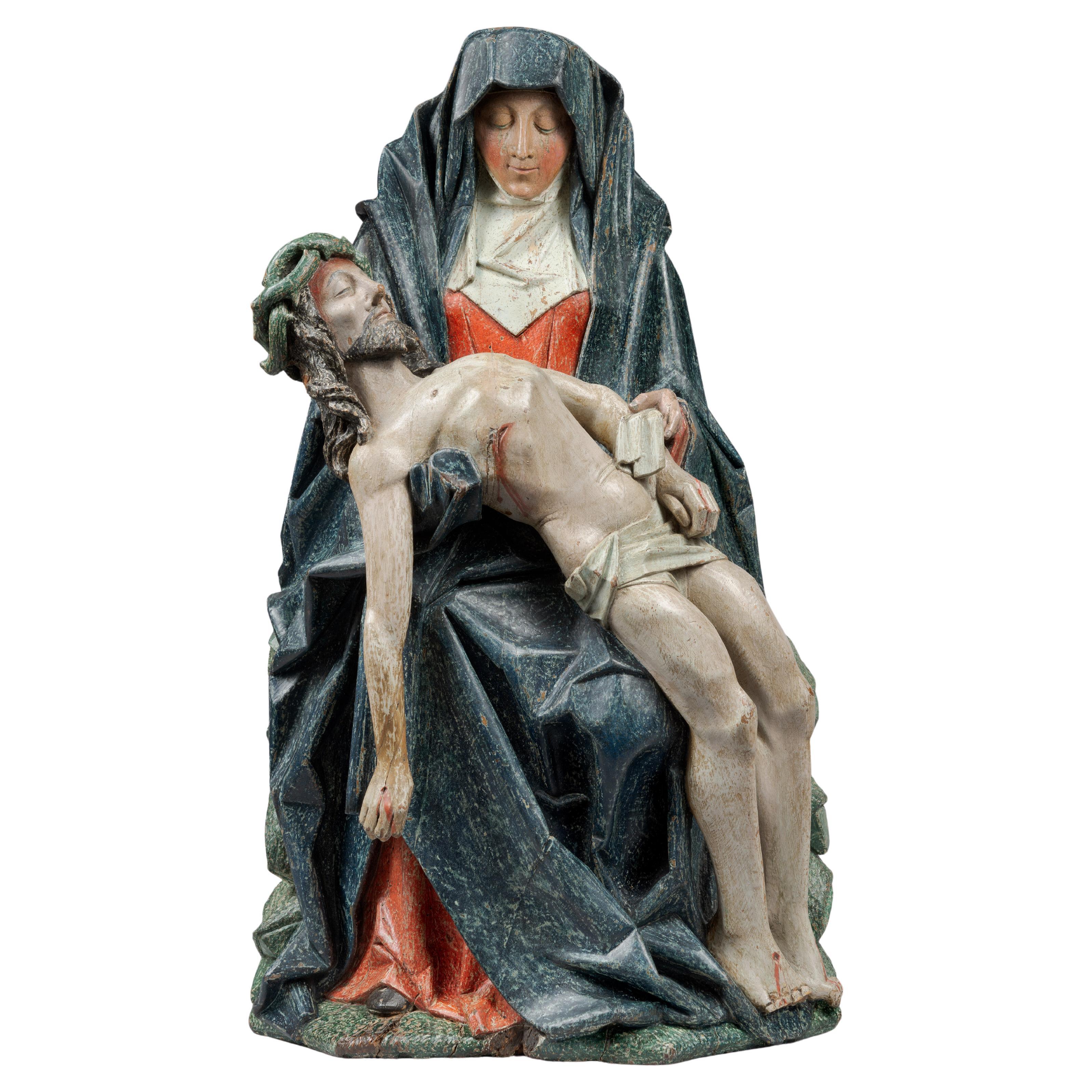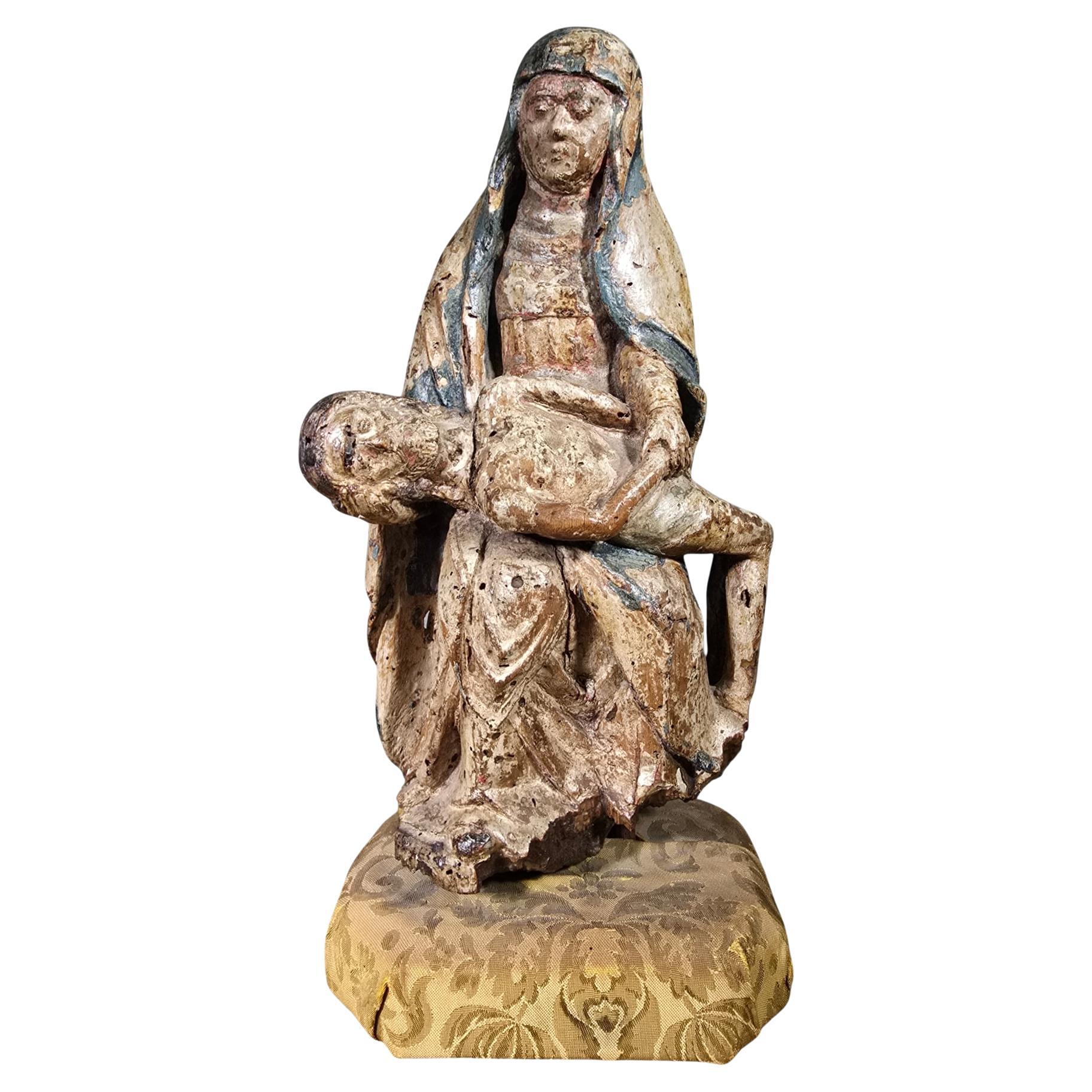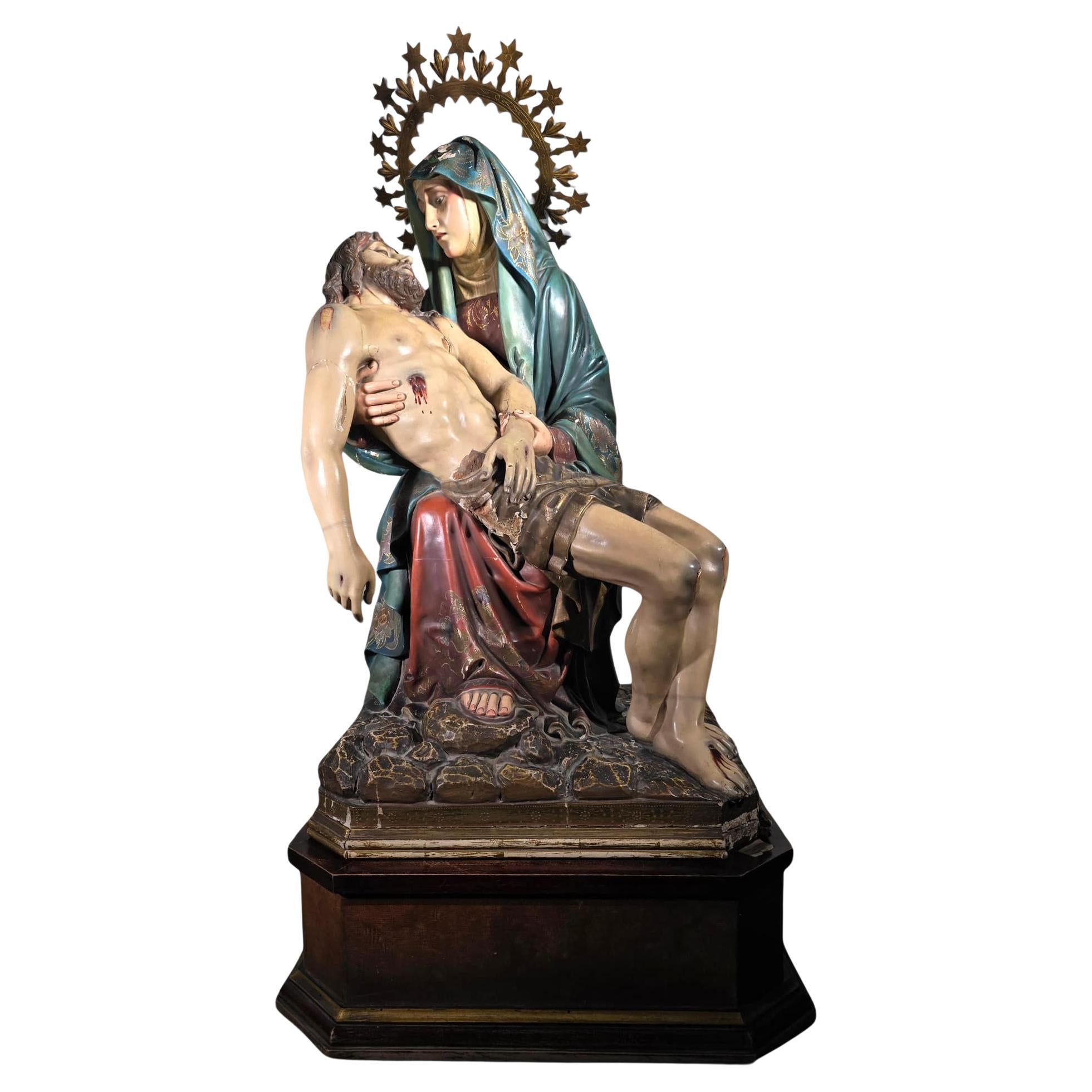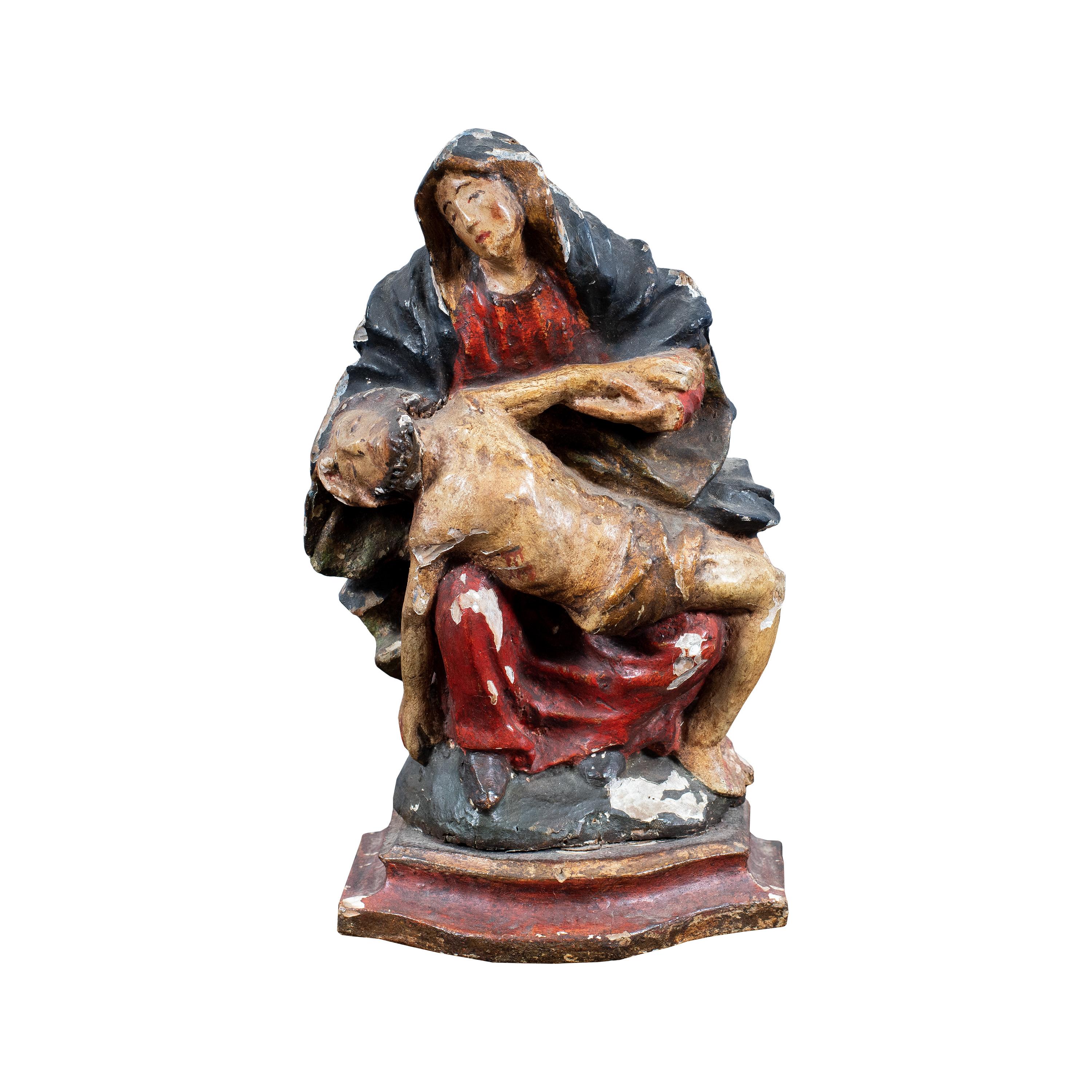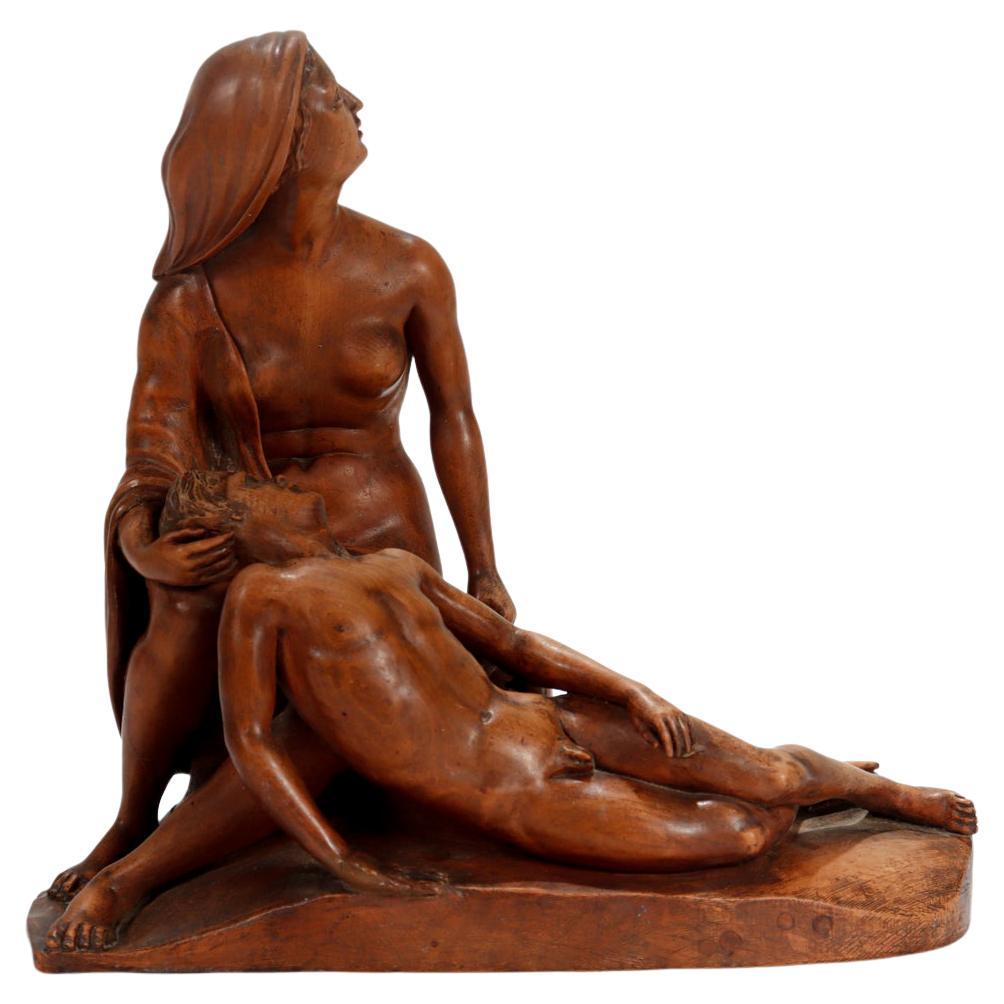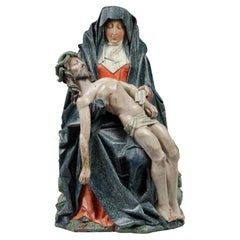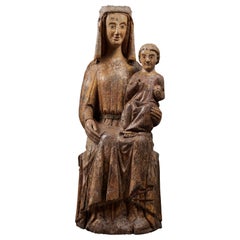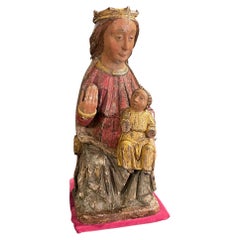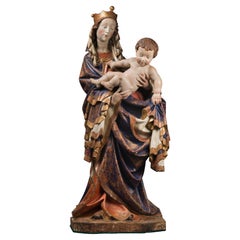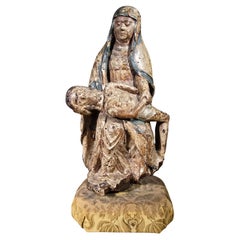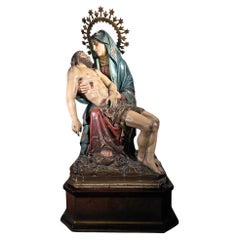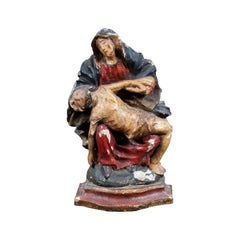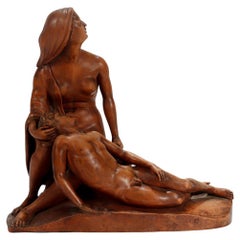Items Similar to Important German Pietà from the, 14th Century
Want more images or videos?
Request additional images or videos from the seller
1 of 4
Important German Pietà from the, 14th Century
$83,230.95
£61,987.75
€70,000
CA$116,735.56
A$128,027.92
CHF 66,029.36
MX$1,529,401.93
NOK 837,453.13
SEK 785,626.06
DKK 533,410.49
About the Item
IMPORTANT GERMAN PIETÀ FROM THE 14th CENTURY
ORIGIN: GERMANY, REGION DE COLOGNE
PERIOD: BEGINNING IF THE 14th CENTURY, ca. 1330
Height: 98 cm
Length: 45 cm
Depth: 33 cm
Polychromed linden wood
Good condition of conservation
Provenance : particular Alsatian collection
The theme of the Pietà or Vesperbild appears in Germany at the end of the 13th century, reflecting the mysticism of the late Middle Ages. Although the theme does not exist in the Gospels, it was often mentioned in contemporary devotional literature. Indeed, during the first half of the 14th century, mystical thought and devotional practices changed under the impulse of a number of religious, among them Heinrich Suso and St Bridget. In his writings, Suso placed important emphasis on contemplation and meditation in the footsteps of Christ's martyrdom.
This will have great impact in the field of art, especially in Germany and later in France. The emphasis will from now on be on grief, death is shown in a straightforward way. The wounds of Christ are gaping and bloody. The suffering of Christ and the seven sorrows of the Virgin Mary are meditated upon.
This piece demonstrates the interest of the faithful in these representations where pathos reigns.
The virgin is represented seated in a frontal position. The bust is very elongated. She is wearing a red dress with a simple neckline and a blue mantel covering her body. Her face is slightly bent forward and is looking at the body of her son, which she is holding in both hands on her lap. The calm face of Christ is reminiscent of the romanesque Christs. His right arm is hanging down, indicating the reality of the death. He has protruding ribs and is covered by a long perizonium. Christ's long hair falls down behind his back.
This Pietà can be compared with a group from The Cloisters museum in New York City. The Virgin Mary and Christ are in a similar position. Christ's ribs are particularly visible with his right arm hanging down.
- Dimensions:Height: 38.59 in (98 cm)Width: 17.72 in (45 cm)Depth: 13 in (33 cm)
- Materials and Techniques:
- Period:
- Date of Manufacture:circa 1330
- Condition:Refinished. Repaired. Replacements made.
- Seller Location:Saint-Ouen, FR
- Reference Number:1stDibs: LU3115334522822
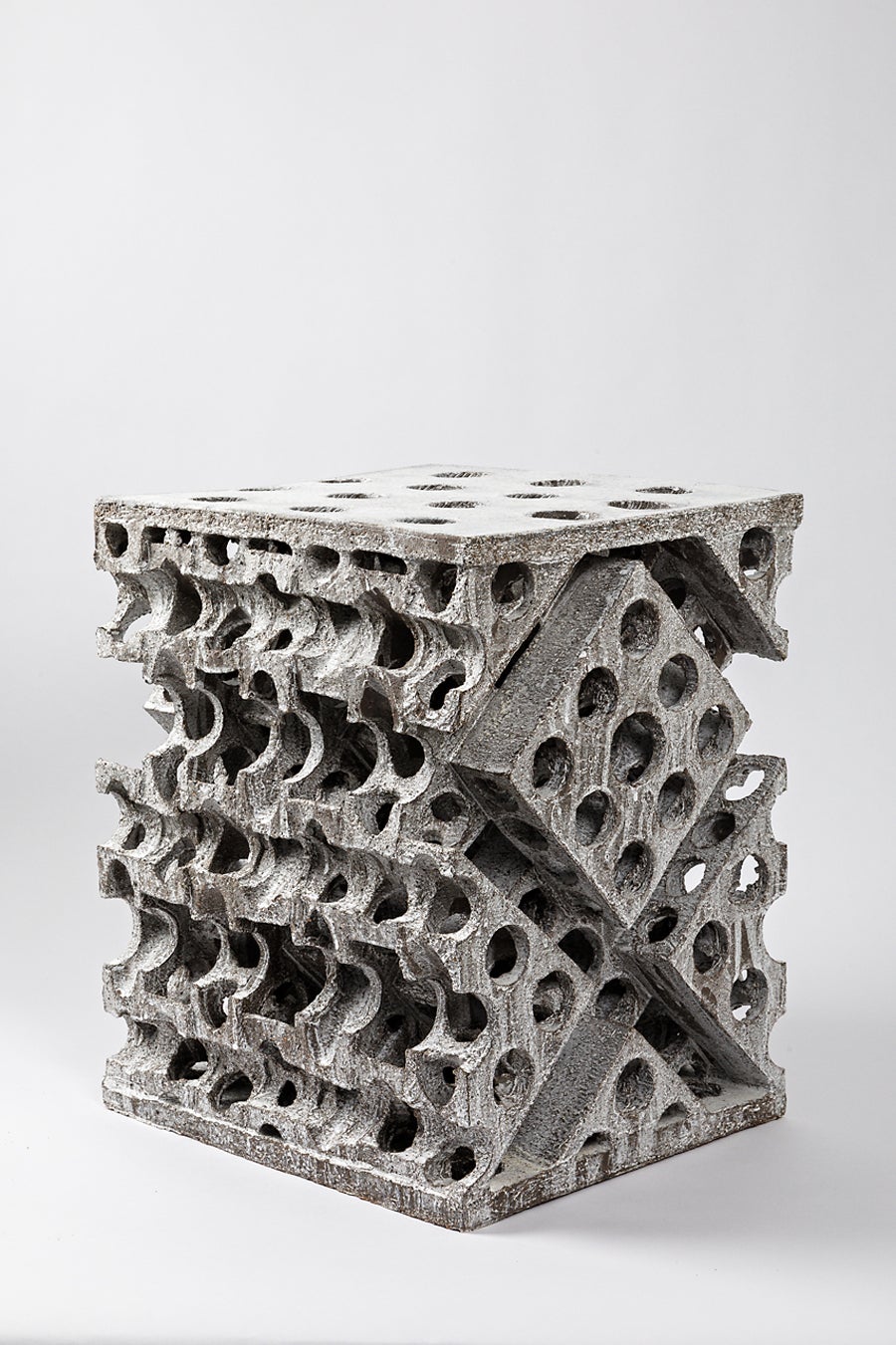
About the Seller
5.0
Vetted Professional Seller
Every seller passes strict standards for authenticity and reliability
Established in 2016
1stDibs seller since 2017
201 sales on 1stDibs
Typical response time: 2 hours
- ShippingRetrieving quote...Shipping from: Paris, France
- Return Policy
Authenticity Guarantee
In the unlikely event there’s an issue with an item’s authenticity, contact us within 1 year for a full refund. DetailsMoney-Back Guarantee
If your item is not as described, is damaged in transit, or does not arrive, contact us within 7 days for a full refund. Details24-Hour Cancellation
You have a 24-hour grace period in which to reconsider your purchase, with no questions asked.Vetted Professional Sellers
Our world-class sellers must adhere to strict standards for service and quality, maintaining the integrity of our listings.Price-Match Guarantee
If you find that a seller listed the same item for a lower price elsewhere, we’ll match it.Trusted Global Delivery
Our best-in-class carrier network provides specialized shipping options worldwide, including custom delivery.More From This Seller
View AllBeautiful German Pieta known as "Vesperbild"
Located in Saint-Ouen, FR
BEAUTIFUL GERMAN PIETA KNOWN AS “VESPERBILD”
ORIGIN : GERMANY
PERIOD : 15th CENTURUY
Height : 74 cm
Width : 43 cm
Depth : 22,5 cm
Good condition
Oak wood
This beautiful 15th-c...
Category
Antique 15th Century and Earlier German Gothic Figurative Sculptures
Materials
Oak
Important Virgin and Child in Majesty
Located in Saint-Ouen, FR
Important virgin and child in majesty
Origin : Germany Or Eastern France
Époque : Second Half Of The 13th Century
Height: 104.5 cm
Length: 3...
Category
Antique 15th Century and Earlier Figurative Sculptures
Materials
Oak
Virgin and Child in Majesty
Located in Saint-Ouen, FR
Virgin and child in majesty
Origine: castille
Epoque: early 14th century
Measures: Height: 72cm
Length: 30cm
Depth: 25cm
Polychrome and gi...
Category
Antique 15th Century and Earlier Figurative Sculptures
Materials
Wood
$41,615
Exceptional Virgin with Child in the Style of Salzburg's Madonnas
Located in Saint-Ouen, FR
Exceptionnal polychrome wood virgin with child in the style of Salzburg’s Madonnas
Origin : Central Europe
Era : 19th century
Measures: height : 123...
Category
Antique 19th Century Figurative Sculptures
Materials
Wood
Virgin and Child in Majesty with a Bird
Located in Saint-Ouen, FR
Virgin and child in majesty with a bird
Origin: Southern Germany Or Austria
Period: Late 13tth - Early 14th Century
Height : 87.5 cm
Length : 32 cm
Depth : 19 cm
Lime ...
Category
Antique 15th Century and Earlier Figurative Sculptures
Materials
Wood
Virgin and Child in Majesty, also known as "Sedes Sapientae"
Located in Saint-Ouen, FR
VIRGIN AND CHILD IN MAJESTY, ALSO KNOWN AS "SEDES SAPIENTIAE"
ORIGIN : SPAIN, CATALOGNE
PERIOD: EARLY 13th CENTURY
Height : 95 cm
Width : 32 cm
Depth : 28 cm
Softwood
No polychromy
In the middle of the 12th century, the Virgin took her place in churches, seated in Majesty, serving as a throne for her son Jesus. She is then called Sedes Sapientiae, meaning the Throne of Wisdom.
At that time, she is not represented for herself and only exists because she has been designated as Theotokos, the mother of God, at the Council of Ephesus in 431, where the divine nature of Christ was proclaimed from his birth.
The upright and perfectly hieratic bust of this Virgin and Child in Majesty is seated on a throne-bench. She is dressed in a tunic with a rounded neckline and covered with a fine mantle placed on her narrow shoulders. The supple and natural drapery follows the lines of the body.
Large curls frame her face with delicate and regular features, a long straight nose, almond-shaped eyes, and small lips.
She supports the Infant Jesus with her left hand. Like his mother, he is dressed in a long tunic, and his little feet are visible in the folds. He holds a small sphere in his left hand, while with his right hand, he gestures in blessing. The face of Christ bears a strong resemblance to his mother’s one, and he gives a slight smile.
The position of the Child is no longer as hieratic, nor frontal or central as in the early 12th century, but his face still turns towards the faithful.
The 13th century indeed emerges as a period of transition in the artistic domain. The statuary, while retaining certain characteristics still belonging to the habits of the previous century, also develops new formal solutions.
As a result, Mary maintains a hieratic and frontal position, while her son shifts to place himself well to the left on her knee. Similarly, while the Virgin seems perfectly still, Jesus, on the other hand, appears much more animated, especially in the positioning of his hands. His left hand holds the orb, and judging by the raised right arm directed towards the faithful, one can easily imagine that he was making a gesture of blessing.
The influence of the Sedes Sapientiae from previous centuries still seems particularly prevalent in this work.
These few characteristics allow dating this Spanish Virgin...
Category
Antique 15th Century and Earlier Spanish Gothic Figurative Sculptures
Materials
Softwood
You May Also Like
Rare 16th-Century French Polychrome Wooden Pietà Sculpture
Located in Madrid, ES
This rare and extraordinary 16th-century French sculpture depicts the iconic Pietà, showcasing exceptional craftsmanship and emotional depth. Finely carved from wood and adorned with...
Category
Antique 16th Century Figurative Sculptures
Materials
Fruitwood
Important 19th Century Sculpture: The Pieta
Located in Madrid, ES
Immerse yourself in the poignant beauty of this significant carved wood and polychrome sculpture depicting the iconic scene of the Pieta. Crafted possibly in Spain during the 19th century, this artwork stands as a striking testament to sacred art and artistic mastery of the era.
The sculpture, executed with exceptional quality, captures the delicacy and devotion of the Pieta scene, where the Virgin Mary cradles the body of Jesus Christ after the crucifixion. Despite some minor losses, as shown in the accompanying photos, these do not significantly diminish the value or beauty of the piece.
Measuring 108x60x55 cm, including the wooden base, this sculpture possesses an imposing presence that will command attention in any space. The expressiveness of the figures and the meticulous attention to detail attest to the sculptor's talent and deep understanding of the religious theme.
Whether as the centerpiece of a sacred art collection or as a standout element in a devotional space, this Pieta sculpture...
Category
Antique Early 19th Century Figurative Sculptures
Materials
Fruitwood
Italian master - 18th century figure sculpture - Virgin Pity - Carved Wood Paint
Located in Varmo, IT
Carved and painted wooden sculpture - Pietà - Italy, 18th century.
13 x 7 x h 22.5 cm.
Entirely made of carved and polychrome painted wood.
Condition report: Good state of conserv...
Category
Mid-18th Century Old Masters Figurative Sculptures
Materials
Paint, Wood
Antique Renaissance Style Wooden Carved Pieta Sculpture with Mary & Christ
Located in Philadelphia, PA
In a Renaissance style.
Possibly Northern European or German.
In the form of the Virgin Mary cradling the lifeless mortal body of Jesus Christ after his removal from the cross. This is known as the Pietà - the sixth of the "Seven Sorrows of Mary" and a common depiction in sculpture.
Carved out of several joined wood blocks.
Simply a wonderful antique Religious sculpture...
Category
Early 20th Century Renaissance Figurative Sculptures
Materials
Wood
Pieta Lime Wood Sculpture Franco Burgundian late 15th century
Located in Pistoia, IT
Beautiful linden wood carving depicting a Pieta. France, Burgundian-Flemish current, late 15th to early 16th century. This theme is not found in the Bible but is derived from apocr...
Category
15th Century and Earlier Northern Renaissance Figurative Sculptures
Materials
Wood
17th Century Spanish Colonial Pietà Sculpture with Sterling Silver Halo
Located in Rio De Janeiro, BR
17th Century Spanish Colonial Pietà Sculpture with Sterling Silver Halo
An extraordinary and deeply devotional example of Spanish Colonial religious art, this 17th-century Pietà capt...
Category
Antique 1690s Peruvian Spanish Colonial Figurative Sculptures
Materials
Wood
More Ways To Browse
Pieta Sculpture
Snake Charmer
Spanish Furniture 15th Century
19th Century Diana Sculpture
Antique Anvil
Black Porcelain Figurines
Bronze Nymph
Carved Wood Putti
Cherub Statues
D Chiparus
Hand Sculpture Chair
Japanese Figurative Wood Sculptures
Large Wood Statue
Life Size Sculpture Of Man Bronze
Mermaid Sculptures
Moreau Figure
Pair Of Wood Statues
Romanesque Furniture
